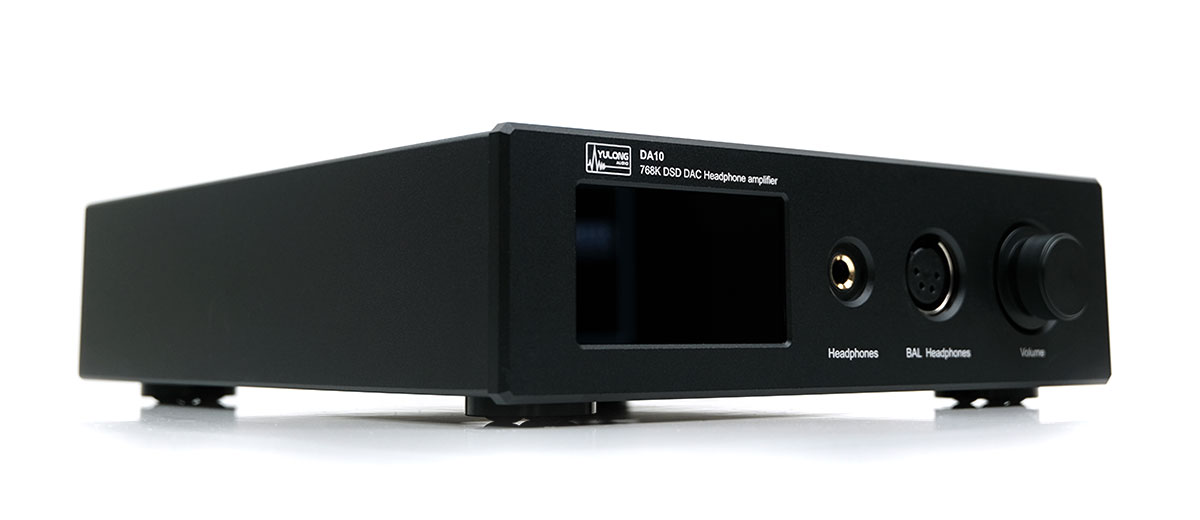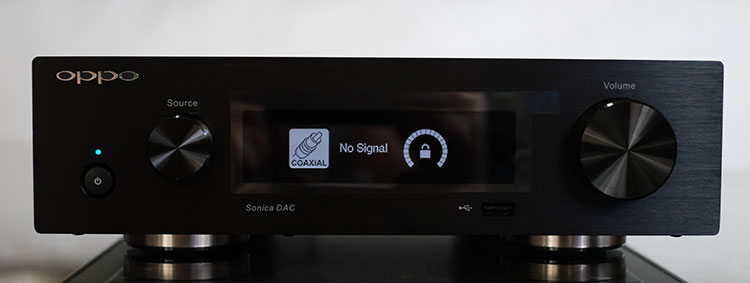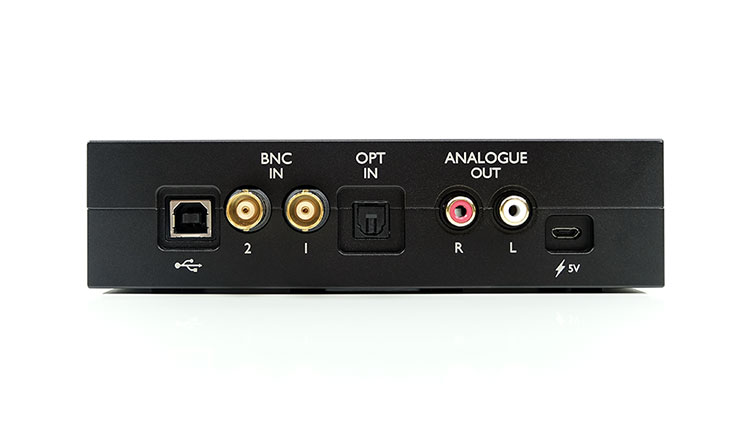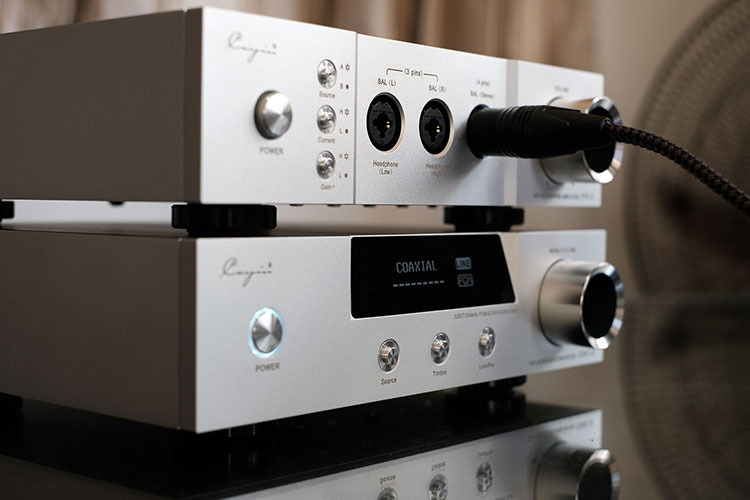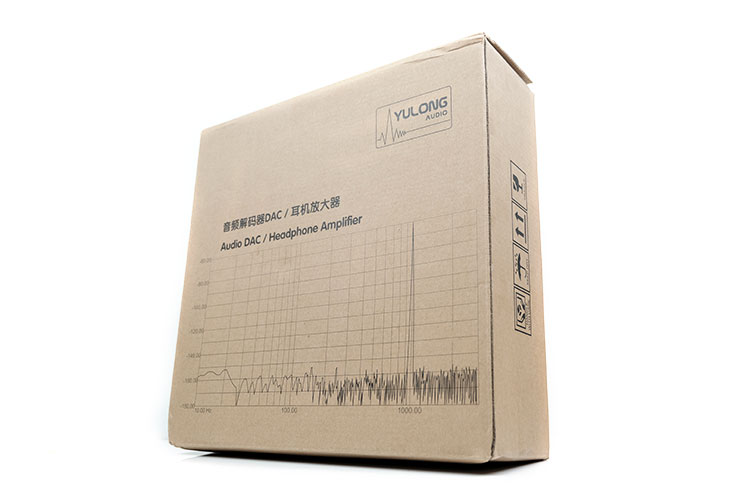Sound Impressions
Pure DAC
As a pure DAC, the DA10’s AK4497 implementation is a little on the full-bodied and warmer side compared to the likes of the Chord Qutest and the Oppo Sonica DAC. These are two DACs I consider to be very linear and clean in their presentation with the Qutest perhaps having a bit more treble energy than the other two.
The DA10 DAC goes in the opposite direction when tested with 2-3 analog amps. You will find the low-end weightier though not punchier. The emphasis seems to be more focused on sub-bass volume rather than a mid-bass punch as the delivery is a touch on the softer side with the integrated amp.
My feeling also that the integrated amp stage of the DA10 is fairly transparent with little or no additional coloration to the DAC. However, the punchiness is not as convincing as when the DA10 is used as a pure DAC to another amp. The pure DAC response is more ‘dynamic’ sounding when paired with amps such as the Auris HA-2SE which does have a lower 1W into a 32Ω rating.
Hands-off
Another aspect of the DA10 pure DAC performance is that beyond the low-end weight the mids and treble are a little ‘hands-off’. What I mean by that is that are not the main focus of the DAC performance in the same way as the older AK440EQ inside Cayin’s iDAC-6 focused on upper mids and lower treble.
However, do not confuse this with some idea that it is diffuse or vague in its delivery. The DA10 DAC mids and treble are very refined, more so than the iDAC-6 with a more pleasing harmonic balance. Rather, it just lacks a little bite and sparkle at the very top. I suspect there is a gentle roll-off here or perhaps not as accentuated as the iDAC-6 AK4490 sound or the more aggressive Qutest.
Timbre
The DA10 instrumental and vocal timbre is slightly euphonic throughout which does add some credence to the slight roll-off in the treble I am hearing. However, it is not a sugary sweet sound, rather just a little more natural and forgiving without any sharp overtones.
It does not have that old AK4490EQ hard edge in the upper-mids and lower-treble that tends to produce a little more vocal sibilance. This is a wetter, more pleasing delivery with a ‘fleshier’ texture to vocals though definitely not lacking in micro-detail.
Headphone Amp
We did some testing with the DA10 pure DAC connected to the Auris HA-2SE and the Cayin iHA-6. In both cases, we found the two dedicated analog amps to be a little punchier and more vivid sounding compared to the DA10 amp stage.
Having said that, comparing the likes of the Qutest and iDAC-6 pure DAC performances the DA10 pure DAC is much more on the smoother and euphonic side, to begin with. Hence, the feeling is that the DA10 amp stage is relatively transparent which means you get plenty of that DAC detail and coloration shining through.
Power
In terms of power, I thought there might be a deficit in power going single-ended with high impedance cans but our 300Ω HD600 was super easy to drive, with current barely at 50% for loudness, (-45 to -40dB volume on the DA10). Going balanced though produces the snappier punchier response and it does feel the DA10’s balanced output is the way to go with the HD600.
Planar headphones have no issues either with the DA10, especially going balanced where they benefit from that additional low impedance output power. We tested Diana Phi, Meze Empyrean, and MrSpeakers Ether, and all three did not sound compressed or lacking in dynamic range with the DA10’s balanced output.
Synergy
Out of the three planars tested I tended to stick with the Phi on the DA10 even though I know I can get a lot more dynamic range and power from some very powerful amps out there.
The reference sound of the Phi seems to pair well with the DA10 smoother, slightly denser timbre, and weightier low-end. The lack of aggressive brightness or slight fade in the upper mids and treble tends to deliver a fairly refined sound with this pairing.
The Phi can be quite unforgiving with poor matches. For example, the iDAC-6’s harder treble harmonic overtone shows up as distracting vocal sibilance with the Phi whereas the DA10 combo has a much more appealing harmonic balance and far less sibilance. Less explosive perhaps, but more enjoyable and natural to my ears in the long run.
The Empyrean was slightly less appealing as a pairing given it already has a fairly relaxed top end and a beefier low-end. I tend to run the Empyrean with the Qutest just to push out a bit more separation and top-end energy.
The Ether/DA10 was actually pretty good, especially with the top-end which can often be a touch lean with some amps and DACs. With the DA10 as both amp and source, the Ether 2’s top-end sounded a touch smoother, less edgy, and lean. These are the type of solid-state sounds I tend to prefer with the original Ether alongside a good tube amp.
Select Comparisons
For a DAC to DAC comparison we used the 3 dual-RCA analog inputs of the Auris HA-2SE headphone amplifier or one for each DAC. This allows us to quickly and accurately switch between the DACs without changing variables in the setup such as a different amp or disparate volume level matching.
We also used 3 headphones set to the 50Ω resistance setting on the HA-2SE; the Meze Empyrean, Abyss Diana Phi, and the MrSpeakers Ether 2.
Oppo Sonica DAC
Discontinued (Originally $799)
Technical
Sadly, Oppo has closed its doors since 2018 and the Sonica DAC is no longer being sold. Of course, you can get it used on eBay, however, the used price right now is kind of high.
When we first reviewed it in May 2017 the retail market was $799 for one of the first sub-$1k DACs to use an ES9038PRO DAC. Combined with WiFi and BT streaming and excellent sound quality I still use this as a benchmark reference DAC today in 2019.
Chipset
The DA10 is more expensive than the original Sonica SRP but then again, the Sonica is a pure DAC only whereas the D10 also includes a discreet Class A amplification stage with balanced and unbalanced outputs. The DA10 also differs in the choice of chipsets with the use of an AK4497EQ compared to the ES9038PRO.
On a pure DAC level, the DA10 matches and in some cases exceed the raw performance numbers of the Sonica but it is unclear if those numbers from Yulong are weighted.
For example, the DA10 SNR and dynamic range are listed at -130dB and 125dB respectively compared to the Sonica’s -120dB and 120dB equivalent but we do know the A-weighting of the Sonica is at 1kHz 20Hz to 20kHz. If I am to presume a similar testing method for the DA10 then the AK4497 implementation will perform at a slightly higher level.
Options
In terms of a line-out, the Sonica can operate a variable pre-out with digital volume control and the DA10 also has a dedicated pre-amp selection with analog volume control. The DA10’s pure DAC output is a fixed voltage level at 2V and 4V though you can also operate the Sonica DAC in the same manner and it is also 2V unbalanced and 4V balanced.
The Sonica DAC has a similar analog output capability as the DA10 using both dual -RCA unbalanced and 3-pin XLR balanced connections for analog amps. Digital inputs are almost the same save for the ABS/EBU connection on the back of the DA10. That means USB, coaxial, and optical.
Decoding capability on these DAC’s inputs differs slightly with both capable of up to DSD 512 and PCM768kHz via USB but the Sonica is only able to offer DoP up to DSD64 compared to the DoP DSD128 capacity of the DA10. The DA10 can also offer PCM 384KHz 24BIT on coaxial whereas the Sonica is still limited to PCM 192KHz/24BIT.
Have & Have Not
The Sonics DAC does have some options that the DA10 does not have. The first is streaming in both WiFi and Bluetooth with an app to connect and allow the Sonica access to TIDAL, (though no MQA). It also has direct LAN connectivity as well as front and rear USB slots for playback directly from flash drives and firmware updates, (moot since Oppo have ceased trading).
Of course, to counter that the DA10 has that discreet Class-A headphone amp inside with balanced and unbalanced outputs of up to 3W into a 32Ω load.
With the DA10, you really do not need anything else beyond a transport or PC with a USB connection to drive most headphones. With the Sonica DAC, you still need an analog amp and combined that this will likely set you back around the same price as a DA10 if not more.
Performance
Using the HA-2SE and a set of Diana Phi’s you can tell the influence of each DAC on this pairing. The Yulong DA10 injects a little more sub-bass weight, mid-bass warmth and a slightly thicker or warmer timbre to go with it. The Sonica DAC is more linear and a little cleaner sounding. The Sonica also delivers slightly more upper-mids presence and treble forwardness.
As a result, I tended to find myself drawn more to the mids and top-end of the Sonica which displayed excellent instrumental separation and a vivid level of vocal clarity. It was perhaps the more holographic sounding of the two DACs as a result. With the DA10, the ears picked up on that slightly heavier low-end delivery but in comparison, the vocals and treble tailed off a bit more and did not sound quite as vivid or forward.
Perhaps you can call it a smoother slightly weightier performance versus a cleaner, linear, and more holographic presentation.
Chord Qutest
£1195
Technical
The Qutest is one of the best DACs I have heard for the price and is in the same ballpark as the DA10 at £1195. Again, this is just a pure DAC so it does not have a headphone amplification stage such as you will find inside the DA10. However, comparing both on a pure DAC level is worth a discussion.
The Qutest DAC draws on the Hugo 2’s next-generation FPGA Xilinx Artix 7 chipset rather than off-the-shelf DAC chips. This is in comparison to the DA10’s FPGA/delta-sigma AK4497 implementation. Two very different approaches to digital audio conversion.
The decoding capabilities of both are top-tier though with both able to decode PCM up to 32BIT/768kHz and DSD512 via USB. The one major difference here though is the use of BNC connections to allow the Qutest to decode up to 32BIT/768kHz via dual BNC. The DA10 does not use a dual-BNC system but does support up to PCM 384kHz/24BIT over SPDIF.
One other thing to note is the THD+N numbers between the two DAC setups. The DA10 is very good at 0.0003%, however, the Qutest is outstanding at <0.0001% (weighted at 1kHz 300Ω).
Options
The Qutest is tiny compared to the DA10 and feature-wise it does not have anything as comprehensive as the options on the DA10. Chord really narrowed the focus of the Qutest to focus on pure DAC capabilities.
You can expand its functionality with the Hugo M Scaler dual-BNC upsampling and it does produce a wonderful sound with an analog amp but that will set you back four grand on top of the Qutest price.
The Qutest thus is quite clean and simple for options with a Dual-BNC connection, unbalanced dual-RCA, optical and USB inputs, and its own dedicated power supply. The DA10 is more comprehensive with balanced analog outs, an unbalanced/balanced headphone amp stage, a preamp, and a more helpful LCD panel to control everything.
It does offer an excellent dual-RCA line-out for analog though with 3 different fixed line voltage strengths at either 1V, 2V or 3V. There is no variable voltage preamp capability as you will find on the DA10.
You can, however, choose filtering options on both DACs with the Qutest having a slightly greater number of filters than the DA10. In practice, the Qutest filters are a bit more refined for me and have a more pronounced effect on the analog output with a choice of 2 neutral and 2 warm filters.
The DA10’s super slow attenuation on the HF is not ideal for everyday use so that leaves just the slow and sharp filters. The additional sound profiles on the DA10 are a little too subtle to bring anything massive to the table.
Performance
The timbre on both of these two DACs differs with the DA10 throwing out a bit more low-end body and warmth. It has a denser note than the Qutest and sounds slightly richer of the two with the HA-2SE amp.
However, technically the Qutest has a better level of dynamic range on the same 2V line-out setting and the better instrumental separation of the two throughout. The Bass isn’t as warm but it sounds punchier and more complex in its layering.
Thus, the Qutest sounds like it can stop and start on a dime with amazing clarity, especially on imaging ques and that doesn’t fade away at any end of the FR. It will deliver more headroom and spaciousness than the DA10 with a blacker background also.
The DA10 rolls off just a little in terms of dynamic range and forwardness the further up into the mids and treble you go. It sounds smoother and more full-bodied than the Qutest but lacks a little sparkle in comparison.
Cayin iDAC-6/iHA-6
$699 each
Purposing
The iDAC-6 and iHA-6 were originally $999 each but got a recent reduction in price to $699 making these a bit of a bargain for the features and performance.
The iDAC-6 is a pure DAC but with a preamp feature and no direct headphone amplification stage. The iHA-6 is a discreet analog fully balanced headphone amp. The DA10 will give you all of that plus the discreet Class-A balanced/unbalanced headphone output but of course, at $1200 you do pay more.
The iDAC-6 is also more of a modular component designed to integrate seamlessly with the iHA-6 amplifier and the iDAP-6 streamer. All 3 have similar designs so the stack looks fairly harmonious. The DA10, of course, can do the job of both the iHA-6 and iDAC-6 for slightly less money but there is no streaming on the DA10.
Technical
Both DACs use delta-sigma DAC chipset implementations but the iDAC-6 is showing its age slightly with a dual AK4490EQ build compared to the more capable, (even if just a single channel) AK4497EQ inside the DA10.
Decoding is thus much more complete on the DA10 at up to 32BIT/768kHz and DSD512 via USB compared to the more limiting 32BIT/384kHz PCM and just DSD128 on the iDAC-6.
The numbers are also much better on the DA10 with a THD+N of just 0.0003% compared to the solid-state performance ceiling of just 0.004% of the iDAC-6. SNR is also much lower on the iDAC-6 at just -110dB compared to the -130dB of the DA10.
The iDAC-6 is unique however for offering both a solid-state and tube buffer option to flavor the sound compares to the solid-state only filtering of the DA10. It is something Cayin enjoys offering on a lot of their platforms though be aware the performance numbers drop a bit compared to its solid-state for noise and SNR. Not surprising considering it is a tube buffer.
Have & Have Not
Both have displays that allow you a measure of interaction with the functionality setup of each DAC and both use a rotary dial to control most of those options.
The iDAC-6 does have a few more features and physical controls compared to the DA10 including options such as timbre control that operates across all the source selects. The preamp and source select have their own dedicated buttons on the iDAC-6 compared to the more minimalist rotary control of the DA10.
Both have line-out and preamp capability though note, the Cayin uses a digital volume control and the DA10 uses an analog control. To the rear, the options for both of these DACs are very similar indeed with both having balanced and unbalanced analog outputs, optical, coaxial, USB, and ABS/EBU digital inputs.
The venting system is also very similar as is the fuse box and power supply. I believe both also use a toroidal power supply though the iDAC-6 version is custom-made.
iHA-6
The iHA-6 is a full balanced discrete amplifier with both balanced and unbalanced output capability though it is an AB or push-pull design and not a Class A. It does offer slightly more impedance matching capability with the low and high 6.35mm unbalanced options as well as a balanced output. It can also adjust for gain and current which the DA10 lacks.
The numbers on the iHA-6’s output stages are excellent with up to 2.2w into a 32-ohm load for the single-ended jack outputs and a huge 7W output for the balanced XLR output. the DA10 almost matches the unbalanced load at 2W into 32Ω but trails the iHA-6 going balanced at just 4W into 32Ω.
Ideally, both have plenty for planar headphones SPL demands though note, like the iDAC-6, the SNR on the iHA-6 is higher than the DA10 at -105dB/110dB (unbalanced/balanced), compared to the -130dB rating of the DA10. On paper, the DA10 should be the quieter of the two.
iDAC-6 Performance
On a high level, both are aiming for a similar tone as a pure DAC. The iDAC-6 does have some low-end coloration with a weighty full-bodied bass response, much like the DA10. However, the AK4490EQ does have its limitations and it is something the AK4497 is much better at producing and that’s the harmonic balance, particularly for vocals.
The iDAC-6 AK4490EQ chipset has a bit more treble energy than the DA10’s AK4497. The DA10 for me sounds a little more faded in the top-end but still quite detailed and a touch wetter by comparison.
What that means is that the iDAC-6 brings a lot more exciting bass/treble contrast to any analog amp you choose to use but its harmonic balance is not quite as refined or as smooth as the DA10.
Vocal timbre is where I tend to find that the refinement differences are the easiest to spot when using the Auris HA-2SE input selector and pairing these two in pure DAC mode.
For example, Anggun’s breathy vocal on “Want you to want me“ from her 2000 Chrysalis album sounds a lot more metallic or harder-edged on the iDAC-6 compared to the smoother fleshier performance of the DA10. You tend to get distracted more by the higher amount of sibilance on the iDAC-6 than the DA10.
iHA-6 Performance
(For this test we switched the DAC analog out of both the iDAC-6 and DA10 to the iHA-6 to allow us to compare both the DA10 and iHA-6 amplification stages evenly).
Power
Let’s get this out of the way first. The iHA-6 has more power than the DA10, almost double via its balanced output so hard-to-drive headphones such as the HE6 might pair better in terms of dynamic range and control.
For high impedance headphones 300Ω upwards, the iHA-6 also seems to have more headroom than the DA10. However, these preferences also depend on timbral preferences and there are a few that need to be discussed between the two.
Timbre
The timbral differences cross both single-ended or balanced output with these two amp stages. The iHA-6 is a little cleaner sounding with an extended and more forwards treble presence than the DA10 amp stage which sounds the more linear of the two.
Treble on the iHA-6 is a little leaner though but not by a considerable amount. It certainly does not come across as overly sharp, even on reference headphones such as the Diana Phi. However, you do get that slightly harder edge to upper-pitched percussion harmonics that can often be heard as sparkle or bite.
The DA10 amp seems more transparent to my ears and whatever I was hearing in terms of a pure DAC in our initial comparisons I heard also on the DA10 amp stage. That means a slightly softer, fuller sound and a vocal that sits a little further back, and a treble that is marginally wetter to my ear.
Preferences
For some, that lack of bite in the DA10 will either be a more pleasurable or euphonic tone or produce a desire for more punch and sparkle. Take your pick but the synergy here is important.
For instance, I would throw in an Ether Mark 1 with the DA10 amp stage far faster than the iHA-6. The treble on the Ether 1 is a little lean at the best of times and suits that smoother sound of the DA10. However, with headphones such as the Meze Empyrean and the Ether 2’s darker full-bodied tone the iHA-6’s more aggressive treble is a little more attention-grabbing.
Our Verdict
The Yulong DA10’s all-in-one desk saver approach to headphones and hifi audio should satisfy a lot of traditional audiophiles.
With the AK4497EQ at its heart, you will find a definite improvement and a more refined sound than older, admittedly punchier, AK4490EQ implementations. Yulong has done a good job killing the edginess in vocal and percussion timbre to produce a very smooth and natural sound.
However, this does need to be balanced by the fact the DA10 implementation can sound smooth to the point where some might find themselves looking for a bit more punch, contrast, and sparkle such as you get with the likes of the Chord Qutest.
For me, the DA10 sound is somewhat of a preference question but it is something you need to consider when looking at your pairing options, be that a set of headphones or an analog amp.
I am also not 100% sure you will need another amp to pair with the DA10 unless you already have a great one in your setup and you want to bring some of that DA10 flavor to your system.
The integrated balanced headphone amp on the DA10 has more than enough power and a good level of transparency for modern and classic headphones, both low and high in impedance, to sound very good indeed.
Yulong DA10 Specifications
- DoP64 and DoP128 support over SPDIF/Optical/AES
- PCM 384KHz 24bit over SPDIF/Optical/AES
- DoP64, DoP128, Native DSD64/128/256 /512 and PCM 16-32bit, 32-768KHz over USB
- SNR: -130dB
- Dynamic Range: 125dB
- THD+N: 0.0003%
- Frequency Response: 20-30KHz-0.15dB
- Crosstalk < -120dB
- Balanced Output level: 4.2V
- Single-end headphone amp 600ohm:110mW 300ohm:230mW 150 ohm:460mW 32 ohm:2W
- Balanced headphone amp 600 ohm:230mW 300 ohm:460mW 150 ohm:930mW 32 ohm:3W
- Headphone output THD+N< 0.001% at full power
- Power consumption: <30W
- Size: 248*210*60mm
- Weight: 4Kg




